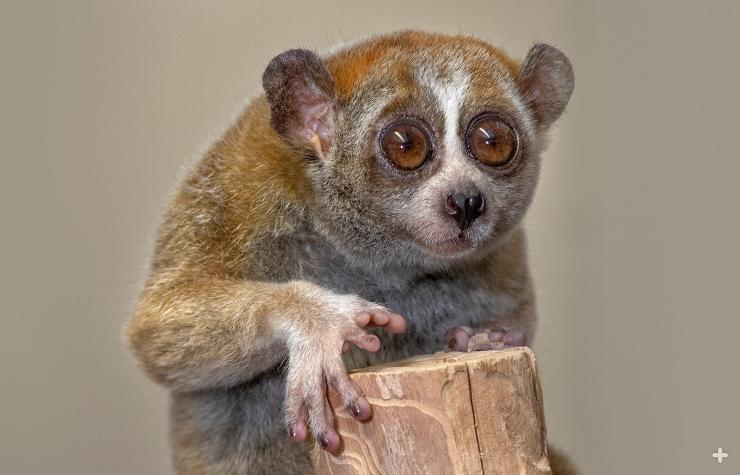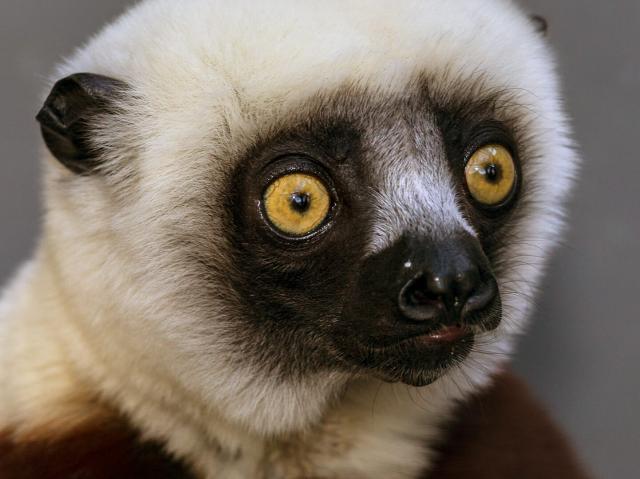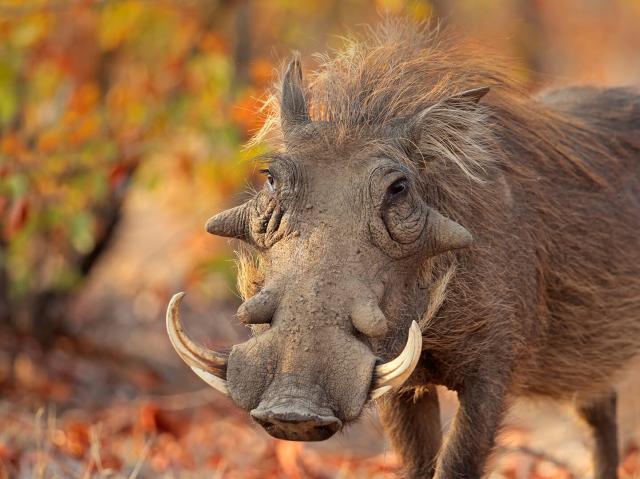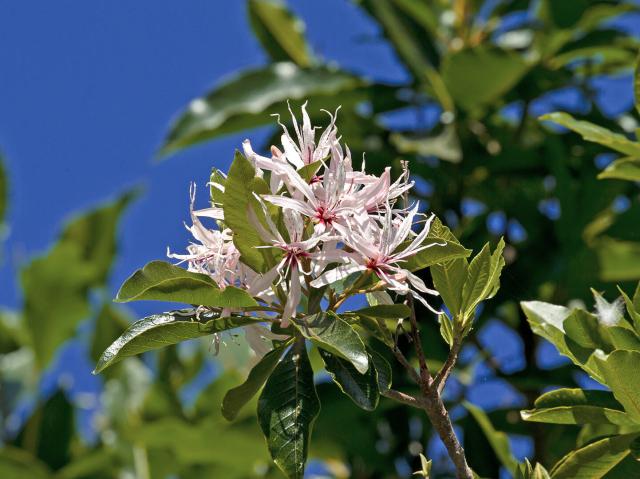
Pygmy Slow Loris

- Class: Mammals
- Order: Primates
- Family: Lorisidae
- Genus: Nycticebus
- Species: pygmaeus

ABOUT
One way for a pint-sized primate to avoid predators and competition for resources is to tuck in by day, rolled into a tight ball, and forage for food at night, stretching slowly from branch to branch. Add to that an uncanny ability to vanish into the trees by staying still for extended lengths of time, as well as producing venom on demand, and you have the most endangered of the non-lemur prosimians: the pygmy slow loris.
What little is known about the pygmy slow loris Nycticebus pygmaeus is intriguing. This species is arboreal, omnivorous, precocial, and generally solitary, with a penchant for polygyny come breeding season. They often hang upside-down by their feet to free up both hands to eat with.
But what really gives the loris a leg up on the simian competition is that it is the only known venomous primate, a highly unusual characteristic among mammals. The loris produces a secretion from glands on the insides of its elbows, which, when mixed with its saliva, serves to venomize its bite. Female lorises sometimes “park” their youngsters while they feed, so they whip up the toxic elixir and lick the little one’s fur to deter predators. Better than a babysitter!
The eyes have it. The first thing you notice on a pygmy slow loris is its huge, round eyes. As a nocturnal hunter and forager, it needs those big eyes to detect its next meal. Packed with retinal rods in its forward-facing eyes, it has sharp depth perception, even among the dim trees. Also enhancing its night vision is a reflective layer of tissue behind the retina called the tapetum lucidum—you may recognize it as eyeshine.
The pygmy slow loris has a short, dense, wooly coat that varies between light brownish to deep reddish brown, with a white chest and belly, and light-colored outlines on its face. Its tail is short to nonexistent, but its dexterous hands (with opposable thumbs) and feet make climbing and hanging around in trees a breeze.
With those big, round night vision eyes, small dark ears, a wet nose, fluffy russet coat with snappy white accents, and plump little gripping digits, the pygmy slow loris is likely the most adorable creature you’ll never see in its native habitat.
Hang on. A pygmy slow loris can hang still from a branch for hours, if necessary. This skill is facilitated by extra vascular bundles in its arms and legs called retia mirabilia, which allow blood to flow to its extremities so it doesn’t experience “pins and needles” from lack of circulation.
I am not a pet! Before you say “I want one” or even click “like” on one of the countless internet videos, know that the illegal pet trade is one of the most horrific threats to lorises—and they make terrible pets!
As noted, they are nocturnal, so bright light is highly stressful for them. Poachers target slow lorises by shining spotlights into the trees, which reflects off a loris's tapetum lucidum—a reflective layer in the eyes that improves night vision—and disorients them as the poacher nabs them.
Sometimes poachers cut the little monkey’s teeth with clippers, wire cutters, or pliers (with no anesthesia) so the buyer won’t be bitten. They transport the monkeys in dark, overcrowded, poorly ventilated containers, resulting in high mortality.
People who keep lorises cannot feed them appropriately, resulting in disease, distress, and early death for the lorises. Loris poaching is a savage black market that informed, compassionate consumers want no part of—no matter how adorable the little lorises are!
The International Animal Rescue launched the Tickling Is Torture campaign to combat viral videos and “cute” photos of slow lorises being kept as pets, which perpetuates the illegal trade of slow lorises. Awareness is key. These fascinating lorises belong in the forest, not under glaring lights getting combed with a toothbrush for social media.
Big threats to a little primate. The pygmy slow loris is also preyed upon by pythons and hawk-eagles (and humans). But they don’t take threats lying down! The first line of defense is a fierce hiss and emitting a strong, don’t-eat-me odor. If it’s still under siege, the loris clasps its arms over its head, a pose that, combined with its facial markings, mimics the expanded hood of an angry spectacled cobra—who would tamper with that? The loris can even undulate in a serpentine fashion (due to extra vertebrae), further deceiving a potential predator.
Slender or slow? It's complicated... The lorisidae family includes African pottos and angwantibos and the Asian lorises. There are two species of slender loris and about eight species of slow loris—the taxonomy of this genus remains fluid—including the pygmy slow loris.
HABITAT AND DIET
At home in many countries. The pygmy slow loris lives in Vietnam (east of the Mekong River), eastern Cambodia, Laos, and the Yunnan province in the south of China; it is sympatric with N. bengalensis.
Slow lorises are difficult to detect even within their known range. It lives in bamboo forest mixed with hardwood trees, forest edge habitat, and dense scrub. Its specialized dentition allows it to gouge trees to induce the flow of gums and sap for consumption. Though surrounded by leaves, they don’t eat them, but occasionally lick them for moisture.
Nest-le in. Slow lorises are arboreal and nocturnal, holing up by day in hollowed-out trees, tree crevices, or branches. They usually curl up in a ball, with their heads tucked up under their arms, making them blend in and stay toasty. When darkness falls, they move with methodical, deliberate hand-over-hand movements, moving fluidly both on top or below a branch. They can move quickly if alarmed, or when snatching an insect out of the air. But they don’t jump or leap to another branch.
Winter break. Pygmy slow lorises are one of the few primate species that slip into torpor (an abbreviated type of hibernation) during cool months (late October to early April). During this time, fewer resources—namely insects—are available, so pygmy slow lorises must cut back somehow. It’s a great survival strategy, as lapsing into extended lengths of inactivity (up to 63 hours at a stretch in one pygmy slow loris study) saves energy, and a lowered body temperature (down to 52 degrees Fahrenheit, 11 degrees Celsius) makes the little snoozers less detectable (and delectable) to predators, like heat-seeking snakes.
Fine dine. The pygmy slow loris eats different types of food. They are opportunistic. According to the Duke Lemur Center, fruits and gums make up more than half of the diet, and insects and small prey items make up another 30 percent. Using its acute sense of smell, lorises effectively hunt and dine in the dark. If a hapless insect goes by, the loris swiftly snatches it out of the air with both hands.
FAMILY LIFE
Click here. Largely solitary and nocturnal, pygmy slow lorises communicate with each other with calls and scent markings. When disturbed, it can emit a strong odor, warning predators to stay away. Then, they may hiss or growl. If the “enemy” is still undeterred, the loris licks its inner elbow area, where it produces a secretion that is toxic when mixed with its saliva (spit). Now its bite has some, well, bite! The venom can debilitate a predator and cause anaphylactic shock in humans.
They are strictly seasonal breeders, with estrus occurring between the end of July and early October. During estrus, the lorises may “whistle” to the opposite sex. Females give birth hanging from branches or sitting in trees. Mothers make a gentle chirping sound to their infants, who respond with clicks and squeaks, especially if in distress. Males mark their territory with urine; his territory may overlap with several females. Home range size is unknown.
Twinning is common, but often one baby is smaller than the other, and that one may be neglected and die. Mothers interact with and take better care of their singleton offspring. More males are born than females, but mortality rates are higher for them. Youngsters likely find suitable foods by smell, as adults scent-mark feeding sites they frequent, such as flower nectaries and gum-oozing wounds in trees.
Branching out Mother lorises may give birth every 12 to 18 months, producing one or two offspring per litter. Gestation is about 188 days. The youngsters are tiny and cling to mom’s belly for the first few weeks. She will “park” her infants in a suitable spot when she has to forage for food. Instead of a babysitter, she may employ her own personal venom, licking the youngster with her noxious saliva to protect it while she’s away. Infants are weaned at about 133 days of age. Her daughters reach sexual maturity at around nine months of age, and her sons take much longer—18 to 20 months.
CONSERVATION
Saving lorises. While their nocturnal arboreal lifestyle makes them difficult to observe, it’s clear the pygmy slow loris is heavily exploited for traditional folk remedies as well as for the illegal pet trade. There has also been a significant decline in their forest habitat—76 percent by some estimates—from logging and military activities.
According to the International Union for Conservation of Nature (IUCN) Red List of Threatened Species, they are classified as Vulnerable, with their numbers decreasing. In 1994, a Species Survival Plan program was established to help conserve pygmy slow lorises; as of 2019 there were about 56 pygmy slow lorises in US-accredited zoos. San Diego Zoo Wildlife Alliance is part of this conservation effort.
By supporting San Diego Zoo Wildlife Alliance, you are our ally in saving and protecting wildlife worldwide.
LIFE SPAN
17 years; 20 years in zoos
YOUNG
Gestation: 187 to 198 days
Offspring: 1 or 2 (twins common)
Age of Maturity: 9 months, females; 18 to 20 months old, males
SIZE
Length: 6 to 10 inches (15 to 25 centimeters)
Weight: 15 ounces (425 grams)
Fun Facts
Some taxonomists consider the pygmy slow loris to be similar enough to the slow loris to be a subspecies. However, most taxonomic classifications group them separately as distinct species.
Other venomous mammals besides the slow loris include the duck-billed platypus, vampire bats, some shrews and moles, and solenodons (shrew-like mammals, related to hedgehogs).
Most venomous mammals are not immune to their own toxins, so sparring males may die from the bites of their rivals.
Pygmy lorises sleep by day rolled up in a ball in the trees with their head tucked snug between their legs.
Lorises are killed for use in folk remedies in Cambodia as a “remedy” for stomach problems, broken bones, and sexually transmitted diseases. There is no scientific evidence to support loris as effective treatment for any human ailments.
Dutch explorers of the 18th century brought back loris specimens, and it is thought that the primates got their name from the Dutch word loeris for "clown," but whether the name was based on the loris’s color pattern or behavior is unknown.











